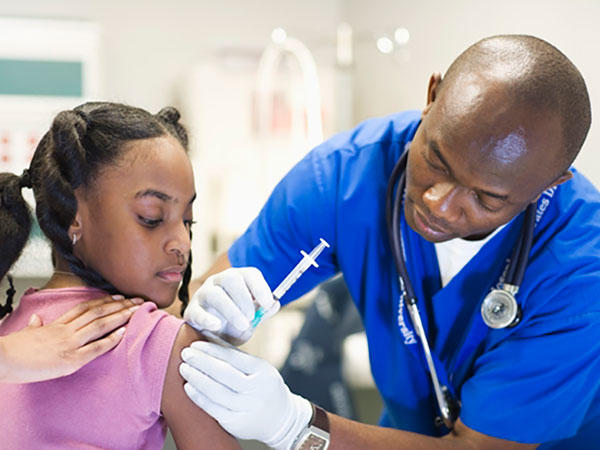
Vaccines can prevent infection with certain cancer-causing viruses.
Credit: Veer
Why Research on Prevention Is Critical to Progress against Cancer
By 2025, an estimated 2.1 million people in the United States will be diagnosed with cancer every year. This is a 31-percent increase from 2012 that is due in part to the aging of the U.S. population and the greater use of cancer screening. The estimated number of annual cancer-related deaths is expected to increase even faster, by 37 percent, from 620,000 to 850,000 by 2025.
These increases make a compelling case for improvements in cancer prevention, and greater progress is possible. It has been estimated, for example, that between 1975 and 2000, tobacco control programs implemented in the United States saved nearly 800,000 lives. Continued efforts against tobacco, together with existing and emerging methods of reducing cancer risk, could pay tremendous dividends in terms of lives saved.
But there are also many obstacles to reducing cancer incidence and mortality in the United States, including socioeconomic disparities, barriers that limit access to health care, and widespread obesity.
Making strides in cancer prevention is not only a public health imperative, it is also an economic imperative. By 2020, the United States will spend an estimated $174 billion each year on cancer care.
Opportunities in Cancer Prevention Research
Studies that have more clearly defined how cancer develops and identified factors that can influence cancer risk are paving the way for important advances in cancer prevention.
Based on this knowledge, researchers are testing new approaches to prevent cancer. This work is informed by studies and programs that:
- identify the biological mechanisms by which common conditions such as obesity and diabetes are associated with cancer risk
- explain how the immune system recognizes and interacts with healthy, pre-cancerous, and tumor cells and test ways to strengthen the immune system's ability to disrupt cancer development
- reveal how drugs used to treat other conditions affect cancer incidence and mortality and test whether they may have a role in cancer prevention
- develop and test ways to address the socioeconomic, biological, and other factors that contribute to higher cancer rates in specific population groups
- analyze the impact of different environmental exposures on cancer risk and develop interventions, including policies, that help to limit those exposures
- identify and test interventions that may prevent the development of cancer in those at increased risk
Challenges in Cancer Prevention Research
Studying cancer prevention and risk reduction has its challenges. Some are related to time. It can take years or decades to determine whether an intervention—such as a new preventive therapy or policies that encourage behavioral changes that can decrease cancer risk—reduces the number of cases or deaths from cancer.
Studies used to identify environmental and behavioral risk factors also require a significant time investment. And conducting these studies comes with the cumbersome logistical hurdles inherent in studying large populations, such as developing and validating tools that accurately measure potential environmental and behavioral risk factors (such as exposure to certain toxins or dietary components and level of physical activity) and, in many cases, monitoring people over time.
Currently, there are genetic tests and risk assessment tools designed to identify people at substantially increased risk of only a few types of cancer. But researchers have struggled to develop tests that can identify people at risk for most types of cancer, due in part to the immense complexity of cancer.
Developing preventive therapies has many challenges. Even as researchers begin to better understand the events in cells that initiate cancer, developing interventions that specifically block or interfere with these events is a complicated and lengthy process.
In addition, prevention research often involves studying a population of people who, although they may be at increased risk of disease, are often otherwise healthy. Consequently, potential preventive therapies must meet a higher bar for safety than therapies used to treat cancer.
And, perhaps with the exception of developing vaccines, the private sector traditionally has had limited interest in spending resources on prevention and risk reduction.
NCI's Role in Cancer Prevention Research
NCI supports and conducts a broad range of cancer prevention research focused on developing and testing preventive interventions, expanding our understanding of the biological processes through which cancer develops, studying ways to reduce cancer risk, and disseminating preventive interventions. The Division of Cancer Prevention (DCP) leads NCI's cancer prevention research efforts and provides funding and administrative support to extramural researchers who conduct cancer prevention research.
The Science of Cancer Prevention
The Science of Cancer Prevention
In this video, Dr. Barry Kramer, former director of NCI's Division of Cancer Prevention, discusses the science of cancer prevention and some of the prevention research that NCI is funding.
New Cancer Prevention Approaches
NCI supports programs and studies that identify and develop interventions designed to reduce cancer risk in people with no history of the disease and to prevent recurrences or second primary malignancies in patients who have already been treated for cancer.
The Pre-Cancer Atlas (PCA), an initiative that is currently under development, will provide a comprehensive analysis of precancerous tissue and its surrounding microenvironment. The goal of PCA is to understand how precancers change to invasive cancer over time. The data generated through this initiative will help develop models for cancer researchers that can both predict and inform new or improved methods to prevent cancer.
The NCI Community Oncology Research Program (NCORP) is a national network that brings clinical trials and studies, including cancer prevention trials, to people in their own communities. NCORP is generating a broadly applicable evidence base that contributes to improving patient outcomes and to reducing cancer disparities.
The PREVENT Cancer Preclinical Drug Development Program helps bring new cancer prevention agents and biomarkers through the early stages of research. The program is currently supporting the development of a number of new agents, as well as the evaluation of several drugs already in use for other diseases and conditions, including aspirin and the diabetes drug metformin.
Through the Phase 0/I/II Cancer Prevention Clinical Trials Program, NCI conducts early-stage trials of new therapies for patients at increased cancer risk. One such trial tested whether sulindac, a nonsteroidal anti-inflammatory drug, reduces the risk of several different cancers in people at increased risk.
Research led by two scientists in NCI’s Center for Cancer Research (CCR) directly contributed to the development of FDA-approved HPV vaccines—work for which they were awarded the National Medal of Technology and Innovation in 2014. CCR scientists are collaborating with other researchers to develop next-generation HPV vaccines designed to have greater capacity to halt HPV infections, which can lead to cervical, oral, anal, and several other cancers.
Researchers from NCI’s Division of Cancer Epidemiology and Genetics (DCEG) led a large clinical trial of the bivalent HPV vaccine that established its safety and efficacy with regard to cervical cancer and HPV-associated cancer at other anatomic sites. The trial has transitioned to an epidemiologic cohort study involving long-term follow-up to evaluate the vaccine’s durability. DCEG scientists continue to analyze data from this trial and other HPV vaccine trials to evaluate the impact of different dosing regimens.
Enhancing Cancer Risk Reduction
Encouraging healthy behaviors that reduce cancer risk underpins NCI’s involvement in the public-private National Collaborative on Childhood Obesity Research (NCCOR). Through NCCOR, researchers in NCI’s Division of Cancer Control and Population Sciences are leading the Family Life, Activity, Sun, Health, and Eating Study to better understand what factors in the lives of children and their families, such as diet, physical activity, tobacco use, and sun exposure, affect their cancer risk.
One of the landmark public health achievements of the past 30 years has been the reduction in tobacco use. NCI's Tobacco Control Research Branch supports studies to monitor tobacco use patterns, identify factors that influence tobacco use rates (such as smoking in movies, advertising at sporting events), and develop and test ways to help tobacco users quit or prevent them from starting in the first place.
DCEG research has helped to identify numerous environmental, biological, and behavioral risk factors that increase cancer risk. A study co-led by DCEG researchers, for example, was the first to definitively link exposure to radiation from computed tomography (CT) scans and cancer risk in children—increasing awareness about the potential risks of medical radiation and emphasizing the need to keep radiation doses during CT procedures on children as low as possible. (For more information, see the page on Causes of Cancer.)
The NCI Cohort Consortium conducts numerous studies using cohorts that include more than 4 million people in the United States and abroad. These studies seek to identify factors (including environmental, lifestyle, and genetic) that may influence cancer risk.
NCI investigators have also been among the leaders in genome-wide association studies (GWAS). By identifying genetic variations that are more common in people with a disease than those without the disease, GWAS are helping researchers better understand the mechanisms of disease initiation and development. Often using data from NCI-supported cohort and case-control studies, NCI-led GWAS have identified hundreds of genetic variants associated with cancer risk. For example, a DCEG study implicated single-nucleotide polymorphisms that play a role in the clearance of the hepatitis C virus (HCV), either spontaneously or in response to treatment.
Prevention and Cancer Disparities
Prevention is an important component in reducing cancer health disparities, including the higher incidence and mortality rates in some population groups.
NCI’s Center to Reduce Cancer Health Disparities supports programs that increase access to and use of preventive measures, such as smoking cessation, in communities in which marked disparities have been documented.
Disparities are also a focus of NCI’s NCORP, which supports prevention-focused clinical studies at the community level. Currently, 12 of NCORP's 34 sites are Minority/Underserved Community Sites, with patient populations comprised of at least 30 percent racial/ethnic minorities or rural residents. (For more information, see the page on Cancer Health Disparities.)
Posted:
Updated:
Reviewed:
Syndicated Content Details:
Source URL: https://www.cancer.gov/node/914512/syndication
Source Agency: National Cancer Institute (NCI)
Captured Date: 2015-08-29 01:00:56.0
Source URL: https://www.cancer.gov/node/914512/syndication
Source Agency: National Cancer Institute (NCI)
Captured Date: 2015-08-29 01:00:56.0





No comments